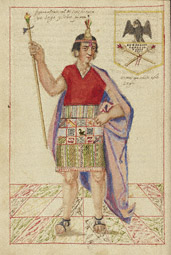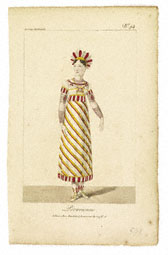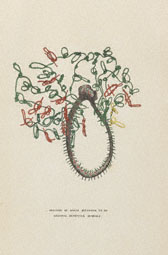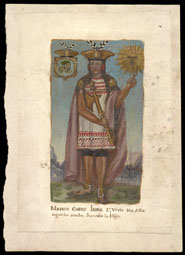 |

 |
 |
Sinchi Roca, unidentified Spanish artist, from Historia general del Piru by Martín de Murúa, 1616
|
 |
When Francisco Pizarro and his fellow Spanish conquistadors first encountered Peru in 1524, they were shocked by the wholly unfamiliar world. The people, flora, fauna, topography, and cities begged for description and communication back to Europe. This exhibition explores the ways that artists depicted Peru and the new visual categories for classifying information they developed.
In conveying the characteristics and history of Peru over the first three centuries of its coexistence with European cultures, the image, accurate or not, was more powerful than text. Images took root in the imagination, defining the region and its cultural identities for the outside world. Knowledge of the exotic New World was compiled and spread through many genres of literature such as costume and botanical books, biographical anthologies, atlases, and travel accounts that were often inaccurate. Fanciful visions of this world persisted alongside more scientific observations until late in the 19th century, even after the new medium of photography seemed to capture life with absolute verisimilitude. The portrayal of Sinchi Roca, above, depicts the second Inca ruler holding a halberd and wearing elements of pre-conquest royal garb: a fringe headdress, a tunic with geometric motifs, a mantle, and sandals. Motifs such as the duck, the coat-of-arms, and the mantle are colonial additions meant to indicate high status to a European audience.
Lea información en español sobre esta obra.
|
 |

 |
 |
Two singing entertainers of Contisuyo, Felipe Guaman Poma de Ayala, from Historia del origen, y genealogía real de los reyes ingas del Piru by Martín de Murúa, 1590
|
 |
 |
At the heart of the exhibition are two illuminated manuscripts by Martín de Murúa, a Spanish friar who arrived in Peru in the late 1500s: Historia general del Piru (1616; General history of Peru [see image at top of page]) and Historia del origen, y genealogía real de los reyes ingas del Piru (1590; History of the origin and genealogy of the Incas of Peru [image at left]). The manuscripts are the first extensively illustrated accounts of the history and customs of the Incas and their lives under Spanish rule. In them, individual kings, queens, and others from the aristocracy and military are depicted with faithfully rendered costumes and other accoutrements.
This scene of two singing figures was painted by Guaman Poma, a native Peruvian. Guaman Poma painted many of the illustrations in Murúa's manuscripts, and wrote and illustrated his own chronicle. His images depict complex narratives about important cities, historical events, religious practices, dress, and other customs, providing a richly textured vision of the Inca and a post-conquest world. This image is an example of Guaman Poma's considerable artistic abilities, in particular his sensitivity to the use of white space, expressive faces, and detailed rendering of Inca dress.
Lea información en español sobre esta obra.
|
 |
 |

 |
 |
Peruvian woman (La Péruvienne), unidentified Peruvian artist, from Amérique Méridionale, ca. 1820
|
 |
This illustration probably represents an actress in the role of a Peruvian woman in one of the many popular European theatrical works of the period. The delicate engraving displays vivid color combinations from contemporary French Empire fashions combined with Peruvian ornament—all imagined. Like other objects in this exhibition, the engraving is an example of the use of Peruvian women in narratives that utilized exotic settings and characters to comment on contemporary European society.
Lea información en español sobre esta obra.
|
 |

 |
 |
Specimen of Knots Supposed to Be Original Peruvian Quipoes, Agostino Aglio, from Antiquities of Mexico... by Edward King, Lord Kingsborough, 1831–1848
|
 |
 |
This illustration is from a monumental publication compiled and published with complete funding by Lord Kingsborough (British, 1795–1837), who was obsessed with the pre-Columbian civilizations of Mexico. Although many of his analyses were based upon mere speculation, Kingsborough's project brought rare American objects to the attention of scholars through their preservation as facsimiles.
The publication generally focuses on Mexican codices and antiquities, but this quipu is one of two Peruvian items also illustrated. A quipu was a writing system of knots and cords constructed in early colonial Peru. The width of each string, the type of knot, as well as its color and placement, affect the meaning of the quipu, which, according to early chroniclers, recorded numerical and historical data. Invented by the Inca, their meanings have yet to be decoded, even though they were utilized well into the colonial period.
Lea información en español sobre esta obra.
|
 |
 |

 |
 |
Women in Procession for the Festival of San Juan de Dios, Francisco (Pancho) Fierro, from "Lima Costumes" by Archibald Smith, ca. 1853
|
 |
In the 19th century, the costumbrismo genre, which celebrated local customs, styles of dress, and scenes of daily life, became a favored subject of painting and literature around the world. In Peru, as elsewhere in the Americas, this genre was part of the construction of collective identities from the earliest accounts in the 16th through the mid-19th centuries. Over time, a standard visual format emerged: single sheets of figures in watercolor on a white ground. Artistic representations of Peruvian types were mainly produced as souvenirs for visiting foreigners; however, the images visually articulated national identities for Peruvian collectors.
Archibald Smith, a British doctor who lived in Lima between roughly 1830 and 1860, compiled this book of Peruvian costumes. An annotation preceding this image states: "The following page represents an Indian procession in the Chorillos, to celebrate one of their peculiar festivals. Among their trophies, they still blend the use of figures representing the sun moon and stars—no doubt in remembrance of the religion of their forefathers."
Lea información en español sobre esta obra.
|
 |

 |
 |
Manco Capac, First Inca Ruler, unidentified Peruvian artist, ca. 1825–1840?
|
 |
 |
This sheet is from a set of 12 portraits of Inca rulers. It is among the last examples in a tradition of Inca genealogies that began in the late 16th century with Murúa and his contemporaries. Like some of Murúa's Incas (see image at the top of this Web page) and those in 16th-century costume books, the kings stand with halberd and coat-of-arms in a landscape. The emphasis is on costume, as shown here with the traditional Inca garb interpreted impressionistically and in the colonial style.
With the fall of the Spaniards in Peru in 1824, imagery of this type flourished in the new Republican era of nascent nation-building, at first to establish noble lineage back to the pre-conquest period. This image and its companions seem to have been made later, by native artists appealing to the flourishing European and American tourist market.
Lea información en español sobre esta obra.
|
 |





